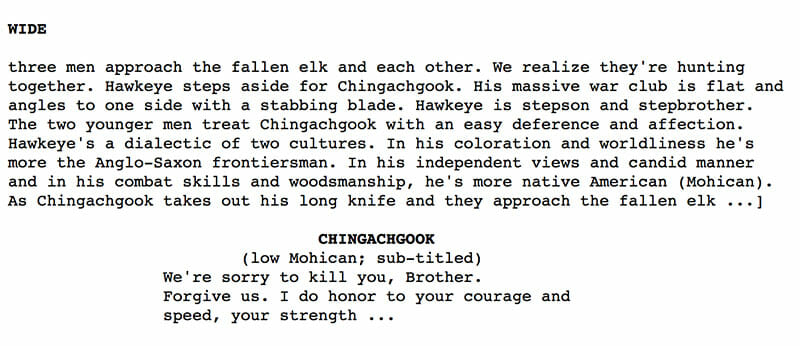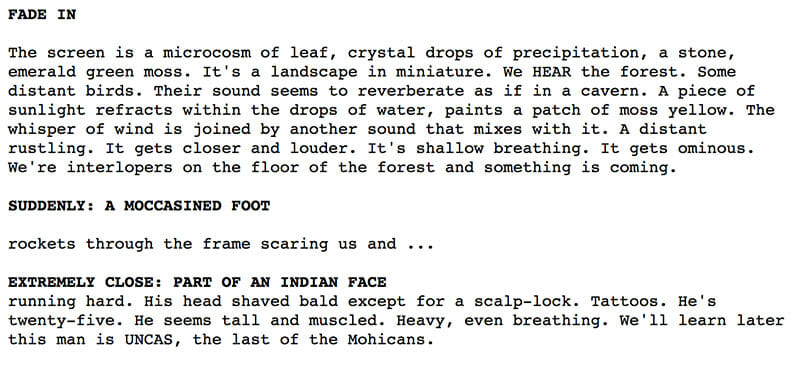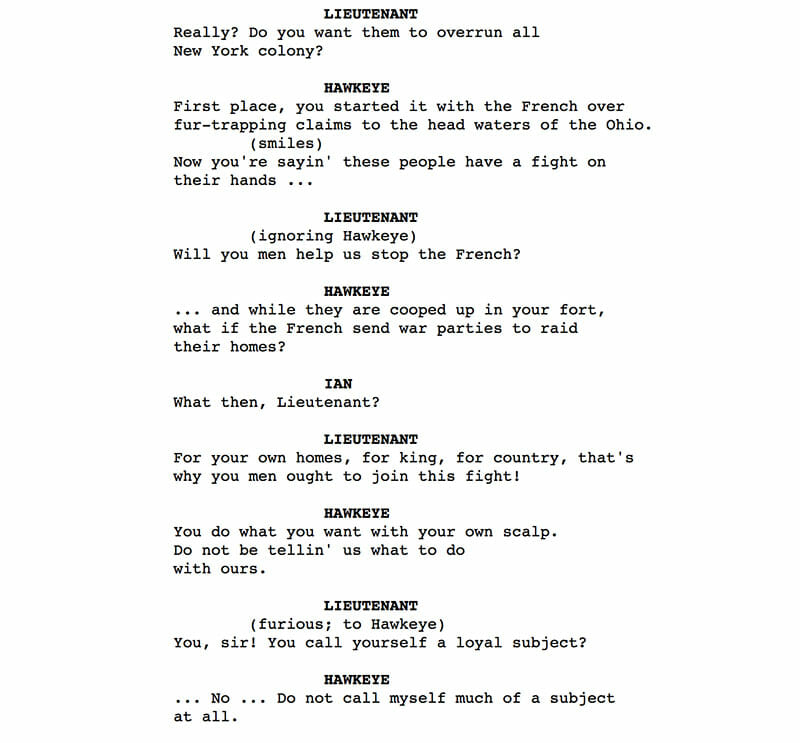Sign up for the
TSL Newsletter
and get $50 off Final Draft 12
By Anthony Faust · June 16, 2017

In a role he was born to play, Daniel Day-Lewis stars in this sweeping historical drama set during the French and Indian War in the 18th century. Director Michael Mann co-wrote the screenplay with Christopher Crowe. The first 10 pages of The Last of the Mohicans is filled with descriptive passages that set the story in motion and observe the first 5 rules of a screenplay in a brisk, skillful manner. Let’s break it down.
The main character is Nathaniel Poe, also known as Hawkeye, who is introduced on page 2, but not before two other characters are introduced first. We see three men, Uncas, Chingachgook, and Poe, charging through an old-growth forest. They are running, but from whom? Or towards what? The writers keep us in suspense for as long as they can, one page, before they hone in on Nathaniel, who raises his rifle and aims it toward a fleeing elk.
By having Nathaniel be the one to make the kill, the writers give us two vital pieces of exposition. First, Nathaniel Poe will be the main character we will follow for the next 120 pages or so. Second, Nathaniel is a warrior and his long rifle – that is also a nickname the French-speaking tribes have given him – will be the instrument he uses to survive his upcoming journey. He will use it to save himself and later Cora Munro, a woman he meets and grows to love.
First impressions are important in life, but in a screenplay, they are crucial. The first time we see a character, he or she should be doing what defines them. When we see Nathaniel, he is running. His character is strong, aggressive, and assertive.
After Nathaniel has killed the elk, what happens next is a small stroke of genius.

By showing the three men paying their respects to their conquest, Mann and Crowe communicate a crucial piece of exposition to us. Uncas, Chingachgook, and Nathaniel are the good guys in this story. They possess the swift ability to take a life, but in the case of the defenseless elk, they are humble enough to understand their place among the colossal trees surrounding them.
The Last of the Mohicans is clearly a period piece. This is a story set in a rustic setting, two decades before the American Revolution. On the first page, Mann and Crowe contrast two scenes to set the tone of the film.

The first three paragraphs paint a picture of simple beauty. The characters in the film will navigate through this wilderness, struggling to survive. They are subject to the natural world they live and work in so it only makes sense that that world grabs our attention first, in the opening paragraph.
The third paragraph is punctuated with a warning. Something is coming. When the moccasined foot tears into the frame, the tranquility disappears and is replaced with an unrelenting energy. Uncas, Chingachgook, and Nathaniel are chasing an elk and this hunt is a foreshadowing of the type of story we are about to read. This is a script about men fighting. They will fight for fortune, they will fight for glory, and they will fight for love.
The world of The Last of the Mohicans is colonial America, with its pristine, cathedral-like forests and the simple, but brutal living conditions that defined the era. The first 10 pages essentially show us three scenes.
First, an elk hunt, which takes place in a forest to emphasize the rural setting of the story. Second, a dinner in a tiny log cabin, where potatoes roast on a fireplace and bread is kneaded by a pioneer woman. Third, a community gathering featuring a mosaic of characters, English soldiers, Mohawk Indians, and militiamen.
It’s not enough to slap a subtitle on the screen telling us it’s the year 1757 A.D. A screenwriter needs to show us the time period and Mann and Crowe do this with their choice of locations in the screenplay’s first few scenes. Their descriptions are deliberate and lengthy.

A meeting between the English and Mohawk Indians begins with an English Lieutenant issuing a call to adventure to the men gathered together. The Lieutenant declares the French as their enemy, but Nathaniel takes exception.


Here the dramatic situation for the screenplay is expressed. The Huron and the French are a threat to Nathaniel and those around him. Nathaniel may be a reluctant warrior, but the time and place for a clash, as we discover in the pages beyond page 10, are not his choosing.
This is what the story is about. Uncas, Nathaniel, and Chingachgook will find themselves tangled up in a guerrilla warfare between two great armies. The stakes rise when Nathaniel meets Cora, rescues her from a Huron ambush, and later falls in love with her.
The theme of The Last of the Mohicans can be gleaned from a conversation between Nathaniel and his friend Jack Cameron on page 5. This takes place after the elk hunt.

A conversation about trading goods quickly turns to the subject of war. Along with the one that follows it, this scene touches on the theme of MAN VS MAN. A long, protracted conflict is being waged and the characters we will invest in over the course of this screenplay will be fighting other men for their freedom.
—
In sum, the screenplay for The Last of the Mohicans begins with a bang and succeeds in using the 5 major rules for a screenplay in its first 10 pages.